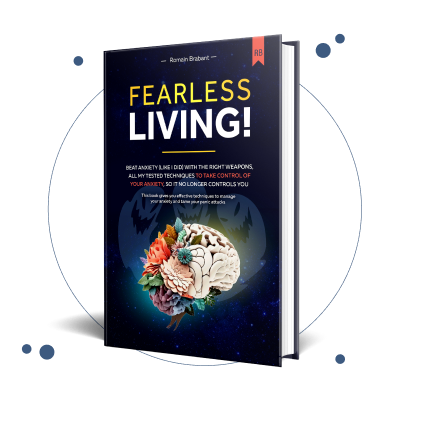
Learning how to manage anxiety isn't about fighting a never-ending battle. It's about understanding that you have the power to heal. This is a journey from feeling trapped by fear to discovering a quiet, steady confidence within yourself. It's about mastering skills to calm panic in the moment, gently shifting your long-term thought patterns, and building a life so resilient that anxiety no longer runs the show. Healing is possible, and a panic-free life is within your reach.
Your Path to a Calmer, Panic-Free Life Starts Now

If you're reading this, you likely know the feeling all too well. The racing heart, the spiral of what-ifs, the bone-deep exhaustion. Feeling trapped by anxiety or the constant fear of the next panic attack can be an incredibly isolating experience.
But here is the most important truth to hold onto: a life of peace, control, and freedom from panic isn't just a distant dream. It is absolutely achievable for you.
This guide is built on practical, hopeful, and proven advice. We're going to walk through how to manage anxiety not as an enemy to be defeated, but as a misguided alarm system you can learn to recalibrate. You have the capacity to heal, and this is where that healing begins.
You Are Not Alone on This Path to Healing
That feeling of isolation anxiety creates? It’s a trick. You are part of a vast community of people who are on the same journey toward healing. Anxiety disorders are the most common mental health issue worldwide, and more people than ever are seeking and finding a way through.
Global data suggests that roughly one in every 23 people is living with a diagnosed anxiety disorder, but a huge number of people never get the support they need. You can find more details about these anxiety statistics to understand the full scope.
This guide is designed to be a bridge to that support and a beacon of hope. It’s a roadmap filled with strategies that have helped countless others move from being stuck in a cycle of worry to feeling empowered, calm, and in control of their lives again.
We'll cover:
- What to do in the moment to regain control when panic hits.
- Long-term strategies to heal your thought patterns and build lasting resilience.
- Simple lifestyle habits that create a foundation for a calm nervous system.
The goal isn't just to become fearless. It's to realize that you are stronger than the fear itself. When you learn how to respond to anxiety with new tools, you reclaim its power. You create space for peace, confidence, and joy to return to your life.
This entire process is about small, consistent steps forward. For a more structured approach, you can explore the essential anxiety recovery steps that lay out a reliable path to healing. And while our focus here is on adults, there are great resources out there for other groups, like these strategies for Managing Anxiety in Children: Strategies for Parents and Caregivers.
The journey to a panic-free life starts with believing that healing is possible and being willing to take that first, small step. Let's walk this path together.
How to Identify Your Personal Anxiety Triggers
To truly heal from anxiety, you first have to understand its language. Think of yourself as a detective on a hopeful mission: to discover the unique signals your body and mind are sending you. Anxiety rarely appears out of nowhere; it’s a reaction to something specific—a situation, a thought, a physical feeling, or an old memory.
Pinpointing these triggers is a foundational step toward reclaiming your life. Once you know what sets your anxiety off, you can shift from simply reacting to every alarm to proactively creating a sense of safety and calm. This isn't just about managing anxiety; it's about dismantling its power and beginning to heal.
Becoming an Expert on Your Own Healing
Your mission begins with compassionate observation, not judgment. The goal is to notice patterns, without criticizing yourself for having them. This is pure information gathering—data that will become your personalized roadmap to a panic-free life.
Many people find their anxiety follows predictable patterns, but they’ve never paused to connect the dots. Does your chest tighten every Sunday night? Does your mind race after too much coffee? These aren't random weaknesses. They are valuable clues pointing the way toward healing.
Start by paying closer attention to your inner and outer world.
- Internal Clues: Notice your thought patterns. Do you get stuck in "what if" loops? Do you replay past mistakes? Even physical sensations like fatigue or hunger can be powerful internal triggers.
- External Clues: Consider your environment. This could be anything from work deadlines and social events to cluttered spaces or even just the evening news.
Understanding the 'why' behind your anxiety is a revolutionary act of hope. It moves you from a place of powerless reaction to one of proactive preparation and healing. This shift is one of the most empowering steps you will ever take.
Start a Simple Trigger-Tracking Journal
One of the most powerful ways to discover your triggers is to simply write them down. You don’t need anything fancy—a notebook or a notes app is perfect. The only requirement is to approach it with consistency and kindness.
For the next week or two, gently note the moments you feel a spike of anxiety. This simple practice creates an incredible feedback loop, revealing connections you might have otherwise missed.
Your journal entries can be short and simple. Just try to capture these key details:
- When did you feel anxious? Jot down the date and time.
- What were you doing? Be specific. Were you driving, in a meeting, or scrolling social media?
- Who were you with? Note if you were alone or with others.
- What were you thinking? Capture the immediate thoughts or worries that came to mind.
- How did your body feel? Did you notice a racing heart, shallow breath, or tight muscles?
- Rate the intensity. Use a simple 1-10 scale to track your progress.
After a week, look back with curiosity. You will almost certainly start to see clear patterns emerge, showing you exactly where you can begin to apply your healing strategies.
Categorizing Your Triggers for Clarity
As you gather your notes, you'll see that your triggers often fall into a few common categories. Grouping them makes them feel less random and far more manageable. When you recognize these patterns, you can anticipate challenges and build coping skills tailored to your needs. For help getting started, you can review this list of common anxiety triggers as a helpful framework.
Recognizing your personal triggers is easier when you can see how they fit into broader categories. This table breaks down the common types with real-world examples to help you organize your own findings.
Common Anxiety Triggers and Their Categories
| Trigger Category | Examples |
|---|---|
| Environmental | Loud noises, crowded spaces, messy or cluttered rooms, bright fluorescent lighting. |
| Social | Public speaking, meeting new people, conflict with a loved one, feeling judged. |
| Physiological | Lack of sleep, too much caffeine, poor nutrition, side effects of medication. |
| Thought Patterns | Worrying about the future, self-criticism, assuming the worst-case scenario. |
| Situational | Financial stress, work deadlines, health concerns, major life changes like a move or job loss. |
By sorting your triggers, you're not just organizing data—you're turning chaos into clarity.
By identifying your personal triggers, you are taking a monumental step on your path to healing. This isn't just an exercise; it's an act of profound hope. It’s the first real proof that your anxiety isn't an uncontrollable force. It's a pattern—and any pattern can be understood, managed, and ultimately, healed.
In-the-Moment Techniques to Calm Panic Attacks
When a wave of intense anxiety or a panic attack hits, it feels like your mind and body have been hijacked. In these moments, being told to "just relax" is impossible.
What you need is a mental first-aid kit filled with techniques that prove you are in control. These practical, fast-acting strategies anchor you back to the present, signaling to your brain that you are safe and sound. Learning these skills gives you a profound sense of hope and agency, proving that you can navigate these storms and come out stronger on the other side.
Ground Yourself with the 5-4-3-2-1 Method
One of the most effective ways to stop a panic spiral is to gently guide your focus out of the storm in your head and into the physical world. The 5-4-3-2-1 grounding technique is a simple yet powerful way to do this by engaging your senses. You can do this anywhere, anytime, and no one will even know.
Imagine you're in a crowded store and feel that surge of panic. Instead of giving in to the urge to flee, pause right where you are and quietly begin:
- 5 things you can see: Look around and name five distinct objects. Really see them. Notice the bright yellow of bananas, the texture of the shopping cart handle, the reflection of light on the floor, a red price tag, and the font on a cereal box.
- 4 things you can feel: Bring your awareness to physical sensations. Feel the solid ground beneath your feet, the cool metal of the cart, the soft fabric of your shirt, and the gentle movement of air on your skin.
- 3 things you can hear: Listen carefully. Tune into the low hum of refrigerators, the distant beep of a scanner, and the murmur of other shoppers.
- 2 things you can smell: Try to identify two distinct scents. Maybe you can smell the aroma from the bakery or the clean scent of floor polish.
- 1 thing you can taste: Focus on one thing you can taste. This could be the lingering taste of coffee, mint from your gum, or simply the neutral taste of your own mouth.
By the time you finish, you’ve successfully shifted your brain’s attention from internal chaos to external reality. You’ve broken the fear cycle and reminded yourself that you are safe.
Calm Your Nervous System with Box Breathing
When panic strikes, your breathing becomes rapid and shallow, intensifying anxiety. Box breathing is a structured technique that directly counteracts this, calming your entire nervous system. It’s used by navy seals and surgeons because it works under pressure, and it will work for you too.
To practice it, imagine drawing a box with your breath.
- Breathe in slowly through your nose for a count of four seconds.
- Hold your breath for a count of four seconds.
- Exhale slowly through your mouth for a count of four seconds.
- Hold your breath again for a count of four seconds.
Repeat this cycle four or five times. The steady rhythm sends a powerful message to your brain that the danger has passed, allowing your heart rate to slow and your body to relax. If you're interested in exploring more ways your breath can be a tool for calm, there are many simple breathing exercises for anxiety you can practice daily.
The following infographic illustrates the key steps to identifying your triggers, which is the first step toward preparing for these moments.

This process shows that proactive management begins with journaling to spot patterns, which in turn allows you to prepare your coping strategies.
Release Physical Tension with Progressive Muscle Relaxation
Anxiety stores itself in your body as muscle tension. Progressive muscle relaxation (PMR) involves systematically tensing and then relaxing different muscle groups. This process not only releases physical stress but also deepens your awareness of your body's signals, empowering you to release tension before it builds.
You can do a quick version even while sitting down.
Start with your hands and feet. Clench your fists and curl your toes, holding the tension for five seconds. Then, release completely, noticing the feeling of warmth and looseness that follows.
Work your way up your body, tensing and relaxing your calves, thighs, stomach, arms, shoulders, and face. This practice is incredibly effective for calming your body for sleep if anxiety keeps you awake.
These in-the-moment tools are your anchors to safety. Mastering them builds unshakable confidence and proves that the fear of the next panic attack doesn't have to control you. Each time you ground yourself, you are rewriting your story from one of fear to one of empowerment. You are proving to yourself that you have what it takes to find calm, even in the middle of a storm.
Rewiring Your Anxious Thought Patterns
While grounding techniques offer immediate relief, lasting peace comes from healing the source of the anxiety—your thoughts. Chronic anxiety is often fueled by distorted thinking patterns that convince you the worst-case scenario is the only one.
Think of it like a sensitive alarm system. It's not your fault it goes off so often, but you can absolutely learn to recalibrate its settings. This is the heart of cognitive restructuring, a powerful way to challenge and rewrite the thought loops that keep you stuck. This is not just coping; this is healing.
Challenging Your Automatic Negative Thoughts
Automatic Negative Thoughts (ANTs) are those quick, judgmental thoughts that feel like facts but are often just old, unhelpful mental habits. For instance, if you make a small mistake, an ANT might scream, "I'm going to get fired," triggering a full physical anxiety response.
By learning to pause and gently question that thought, you create space for a more balanced, hopeful perspective to emerge. You shift from being a passive victim of anxious thoughts to an active participant in your own healing.
The Thought Record: A Powerful Tool for Change
A 'thought record' is a practical exercise to make the invisible process of worry tangible and manageable. It helps you capture an anxious thought, examine it with curiosity, and find a more realistic alternative.
Let's walk through an example. Imagine you have a presentation coming up.
- Situation: Thinking about next week's presentation.
- Anxious Thought: "I'm going to completely fail. Everyone will think I'm incompetent."
- Feelings: Panic, dread, tightness in chest (rated 9/10).
Now, put that thought on trial with gentle curiosity:
- What's the evidence for this thought? "I felt nervous during my last presentation."
- What's the evidence against this thought? "I've prepared for weeks. My manager said my outline was strong. I've given plenty of successful presentations before."
- What's a more balanced, realistic thought? "Feeling nervous is normal, but I am well-prepared. Even if I stumble, I know the material and can handle questions. I am capable of doing this well."
This final step isn't about fake positivity; it's about finding a more accurate, less catastrophic truth. You are systematically training your brain to stop accepting its first anxious draft as the final story.
This process isn't a quick fix. It’s a skill you build with practice, like strengthening a muscle. Each time you challenge a distorted thought, you weaken the old neural pathway and build a new, more resilient one. This is how you create real, lasting change and live a life that isn't dictated by panic.
Recognizing Common Cognitive Distortions
These automatic negative thoughts often fall into predictable patterns called cognitive distortions. Learning to spot them is a game-changer. Some common ones include:
- Catastrophizing: Blowing a small negative event into a life-ending disaster.
- Black-and-White Thinking: Seeing things as all-or-nothing. If it's not perfect, it's a failure.
- Mind Reading: Assuming you know what others are thinking without any real evidence.
Recognizing these helps you see it's not you—it's just your brain running an old program. To learn more, read our complete guide on common cognitive distortions.
Remember, you are far from alone. In the United States, anxiety affects nearly one in five adults. Projections show that about 19.1% of the population will be affected in 2025. Of those, roughly 22.8% report serious impairment, showing how deeply these patterns can impact life. You can discover more 2025 anxiety statistics and see the bigger picture.
By consistently identifying and rewriting anxious thoughts, you're doing more than just coping—you are fundamentally rewiring your brain for calm, confidence, and a panic-free future.
Lifestyle Habits That Build Resilience to Anxiety

True, lasting freedom from anxiety is built on the small, consistent choices you make every day. Think of it as building a strong foundation for your mind and body, making you naturally more resilient when stress arises. This isn't about a massive overhaul but about small, sustainable changes that add up to profound peace.
Each positive choice is a powerful step toward a life with less panic and more joy.
Fueling Calm with Mindful Nutrition
The connection between your gut and brain is powerful. What you eat directly impacts your mood, making your diet a key tool in your healing toolkit.
Some foods can put your nervous system on high alert. Excess sugar can cause energy crashes that mimic anxiety, while too much caffeine can trigger a racing heart. Conversely, some nutrients actively promote calm.
- Magnesium-Rich Foods: Often called nature's relaxant, magnesium helps regulate neurotransmitters. Find it in almonds, spinach, and dark chocolate.
- Omega-3 Fatty Acids: Found in salmon, walnuts, and flaxseeds, these support brain health and help reduce anxiety symptoms.
- Complex Carbohydrates: Foods like oatmeal and quinoa help maintain steady blood sugar and promote serotonin, a mood-stabilizing chemical.
Making small swaps can make a surprising difference. For a deeper dive, explore these lifestyle and diet changes for anxiety management.
The Power of Restorative Sleep
Anxiety and sleep are deeply connected. Worry keeps you awake, and a lack of sleep sends anxiety soaring. Breaking this cycle is a game-changer for healing. Prioritizing good "sleep hygiene" retrains your brain and body to embrace restorative rest.
This is especially critical now. Recent data from the UK showed over 204,000 new referrals for anxiety in patients aged 17 or under post-pandemic. Among those aged 16 to 29, roughly 28% experienced some form of anxiety, highlighting how vital foundational habits like sleep are for healing.
A calming sleep hygiene checklist can help.
- Create a Tech-Free Zone: Stop using screens at least an hour before bed. The blue light disrupts melatonin, the sleep hormone.
- Stick to a Schedule: Go to bed and wake up around the same time daily, even on weekends, to regulate your body's clock.
- Establish a Calming Ritual: Read a book, listen to calm music, or do gentle stretching to signal it's time to wind down.
- Optimize Your Environment: Keep your bedroom dark, cool, and quiet.
Think of your sleep routine as a gentle landing strip for your mind. By creating a predictable and peaceful transition, you signal to your anxious brain that it's safe to power down and recharge.
Gentle Movement as a Natural Anti-Anxiety Tool
Physical activity is one of the most powerful natural anti-anxiety tools available. You don't need to run a marathon to feel the benefits.
A gentle 15-20 minute walk outside can work wonders. It helps burn off stress hormones like adrenaline and cortisol while boosting endorphins, your body's natural mood elevators.
Think about building small pockets of movement into your day.
| Activity Idea | How It Helps |
|---|---|
| Morning Walk | Exposure to natural light helps set your circadian rhythm, improving sleep and mood. |
| Midday Stretches | Releases physical tension that builds up from stress. |
| Dancing in the Kitchen | A fun, low-pressure way to get your heart rate up and release endorphins. |
Cultivating these habits provides a sense of control and predictability, which is incredibly soothing. For more guidance, explore tips on how to stick to a routine effectively that supports your mental health.
Each healthy meal, restful night, and short walk is a loving act of self-care. You are actively building a body and mind that are stronger and calmer. This is the foundation upon which a panic-free life is built.
When to Get Professional Support for Anxiety
Walking the path of managing anxiety is a journey you don't have to take alone. While the tools we’ve covered are powerful, sometimes professional support can accelerate your healing. Deciding to get help isn't a sign of failure; it's an act of incredible strength and a declaration of hope for your future.
Think of therapy as a strategic partnership. It’s an investment in your well-being, where you get a personalized roadmap and an expert guide to help you find a life with less panic and more peace. It is the place where your healing can truly blossom.
Recognizing the Signs It’s Time to Talk
The tools in this guide can make a huge difference, but if anxiety is consistently getting in the way of the life you want to live, professional support is a wise and courageous next step.
Does any of this sound familiar?
- Disruption to Daily Life: Your anxiety makes it tough to function at work, at home, or in your responsibilities.
- Strained Relationships: Worry or avoidance is creating distance with the people you love.
- Loss of Joy: You’ve stopped doing things you once enjoyed because the anxiety feels too big.
- Physical Symptoms: You’re dealing with chronic headaches, digestive issues, or fatigue tied to stress.
If you’re nodding along, it doesn't mean you're broken. It simply means it's time to add a specialist to your support team.
Finding the Right Therapeutic Approach
The world of therapy can feel confusing, but most effective anxiety treatments aim to help you change your relationship with your thoughts and feelings. Two of the most common, evidence-based approaches for anxiety are:
- Cognitive Behavioral Therapy (CBT): This practical, goal-oriented therapy helps you identify, challenge, and reframe distorted thought patterns, giving you concrete skills to change your thinking and behavior.
- Acceptance and Commitment Therapy (ACT): This approach is less about fighting anxious thoughts and more about learning to coexist with them, accepting their presence while committing to actions that align with your values.
Your first session with a therapist is not a test. It’s a conversation. It's a chance to feel understood and to begin charting your unique path to a panic-free life.
Finding the right person is key. Look for a licensed professional—a psychologist, counselor, or social worker—who specializes in anxiety. Many offer a free initial consultation, which is a perfect, low-pressure way to see if their style feels like a good fit.
Taking this step is a powerful expression of hope. It's a declaration that you believe a calmer, more joyful, panic-free life is possible—and that you're ready to take the steps to get there. You have the capacity to heal, and the right support can make all the difference on your journey.
At The Anxiety Checklist, we believe everyone deserves to live a life free from the grip of panic. Our Fearless Living system was created to be that structured, compassionate guide on your journey. It combines a comprehensive eBook with an interactive checklist to give you a clear, step-by-step plan for managing anxiety and reclaiming your life. Start building your personalized toolkit for lasting mental wellness today at https://anxietychecklist.com.

